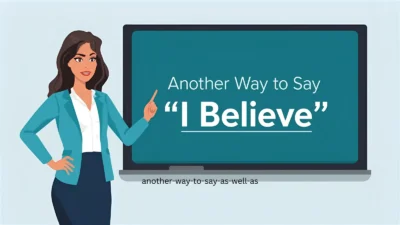The phrase “as well as” is commonly used to add information or connect two related ideas. It works as a smoother, more formal version of “and”, but overusing it can make your writing feel repetitive. Luckily, there are many alternatives that allow you to vary tone, level of formality, and emphasis.
In this article, you’ll find 40 effective alternatives to “as well as”, each with meanings, explanations, examples, best uses, and tone descriptions.
1. Along With
Meaning: Adds something to the main subject.
Explanation: A natural, widely used alternative to as well as.
Example: “She brought her laptop, along with her notes.”
Best Use: Everyday writing, business communication.
Tone: Neutral, professional.
2. Together With
Meaning: Indicates things are combined or joined.
Explanation: Stronger emphasis on unity than as well as.
Example: “The CEO, together with the board, approved the decision.”
Best Use: Formal writing, reports, announcements.
Tone: Formal, authoritative.
3. In Addition To
Meaning: Introduces extra information.
Explanation: Slightly more formal, often used in essays.
Example: “In addition to her studies, she works part-time.”
Best Use: Academic writing, professional contexts.
Tone: Formal, clear.
4. Coupled With
Meaning: Suggests combination or pairing.
Explanation: Adds a sense of strong connection.
Example: “His determination, coupled with his skills, led to success.”
Best Use: Analytical writing, essays.
Tone: Formal, intellectual.
5. Plus
Meaning: Adds something casually.
Explanation: Short, modern, often informal.
Example: “The hotel is affordable, plus it’s near the beach.”
Best Use: Informal speech, marketing, casual writing.
Tone: Friendly, conversational.
6. And
Meaning: Joins two or more ideas.
Explanation: The simplest connector, less formal.
Example: “She likes reading and painting.”
Best Use: All contexts, simple writing.
Tone: Neutral, universal.
7. Combined With
Meaning: Emphasizes the effect of two things together.
Explanation: Stronger than as well as, often cause-and-effect.
Example: “His experience, combined with his vision, impressed the team.”
Best Use: Reports, essays, speeches.
Tone: Formal, confident.
8. Together With The Help Of
Meaning: Adds teamwork or assistance.
Explanation: Highlights collaboration.
Example: “She completed the project, together with the help of her peers.”
Best Use: Collaborative contexts, presentations.
Tone: Supportive, explanatory.
9. In Conjunction With
Meaning: Indicates two things working together.
Explanation: Very formal and professional.
Example: “The software works in conjunction with advanced security tools.”
Best Use: Technical, legal, professional writing.
Tone: Formal, precise.
10. Alongside
Meaning: Refers to something happening or existing together.
Explanation: Common in both formal and informal contexts.
Example: “He worked alongside his mentor.”
Best Use: Professional reports, stories, teamwork contexts.
Tone: Neutral, balanced.
11. As Well
Meaning: Simple and casual, often used at the end of a sentence.
Explanation: Shorter than as well as.
Example: “She speaks French and Spanish as well.”
Best Use: Informal speech, casual writing.
Tone: Friendly, relaxed.
12. Accompanied By
Meaning: Indicates being joined by someone/something.
Explanation: Adds formality and imagery.
Example: “The manager, accompanied by her assistant, entered the room.”
Best Use: Narration, formal writing.
Tone: Formal, descriptive.
13. In Tandem With
Meaning: Suggests two things working side by side.
Explanation: Often used for cooperation or systems.
Example: “The policy works in tandem with new regulations.”
Best Use: Technical, professional contexts.
Tone: Formal, precise.
14. Together With The Support Of
Meaning: Shows added contribution.
Explanation: Useful when highlighting help or resources.
Example: “He succeeded, together with the support of his friends.”
Best Use: Motivational writing, personal stories.
Tone: Supportive, reflective.
15. As Accompanied By
Meaning: Adds extra detail to the main idea.
Explanation: Similar to accompanied by but softer.
Example: “The dish was served, as accompanied by a glass of wine.”
Best Use: Descriptive, narrative writing.
Tone: Formal, literary.
16. In Partnership With
Meaning: Shows collaboration or joint effort.
Explanation: Often used in business or organizational contexts.
Example: “The project was launched in partnership with local charities.”
Best Use: Business, professional writing.
Tone: Formal, cooperative.
17. Together With Others
Meaning: Includes additional, unnamed contributors.
Explanation: Keeps things general while showing group action.
Example: “The policy was supported by the mayor, together with others.”
Best Use: General discussions, summaries.
Tone: Neutral, collective.
18. In Alliance With
Meaning: Highlights strong cooperation.
Explanation: Formal and often used for organizations.
Example: “The country acted in alliance with its neighbors.”
Best Use: Political, organizational writing.
Tone: Formal, authoritative.
19. Side by Side With
Meaning: Literally or figuratively working together.
Explanation: Adds imagery and emotion.
Example: “She stood side by side with her best friend.”
Best Use: Personal writing, speeches, stories.
Tone: Warm, supportive.
20. With the Addition Of
Meaning: Introduces something extra.
Explanation: Direct, neutral, slightly formal.
Example: “With the addition of a new feature, the app became more popular.”
Best Use: Reports, business writing.
Tone: Formal, factual.
21. In Combination With
Meaning: Emphasizes two things working together.
Explanation: Slightly technical, professional.
Example: “The medicine is effective in combination with a healthy diet.”
Best Use: Academic, scientific writing.
Tone: Formal, precise.
22. Along With the Rest
Meaning: Adds an item to a larger group.
Explanation: Simple, casual, inclusive.
Example: “He carried his books, along with the rest of his belongings.”
Best Use: Informal or narrative contexts.
Tone: Conversational, descriptive.
23. As Well As That
Meaning: Adds extra information beyond the main idea.
Explanation: Slightly casual but versatile.
Example: “She’s kind, as well as that, she’s hardworking.”
Best Use: Casual writing, informal essays.
Tone: Conversational, light.
24. With
Meaning: The simplest connector word.
Explanation: Minimal and flexible.
Example: “The plan, with minor changes, will be implemented.”
Best Use: Everyday language, concise writing.
Tone: Neutral, simple.
25. Plus the Fact That
Meaning: Adds emphasis to additional information.
Explanation: Slightly casual, explanatory.
Example: “The hotel is cheap, plus the fact that it’s close to the airport.”
Best Use: Informal writing, persuasive speech.
Tone: Conversational, persuasive.
Conclusion
While “as well as” is useful, it can sound repetitive or overly formal if used too often. Alternatives like formal expressions (in conjunction with, in addition to, in partnership with), casual choices (plus, and, as well), and descriptive ones (side by side with, accompanied by) allow you to adapt your tone to the situation. Choosing the right alternative makes your communication smoother, more engaging, and more professional.



